2018 MERCEDES-BENZ SLC ROADSTER wheel
[x] Cancel search: wheelPage 276 of 298
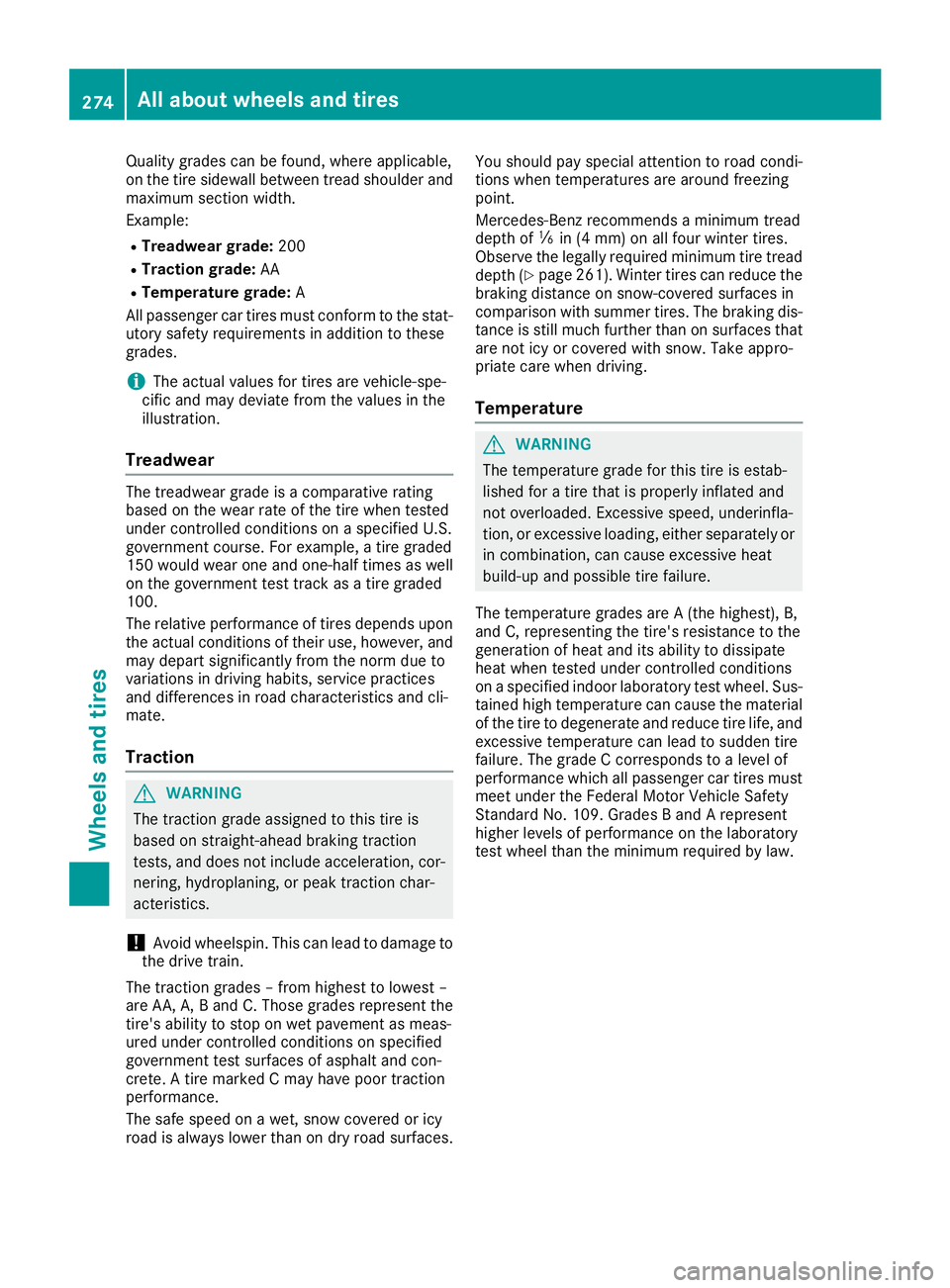
Quality grades can be found,where applicable,
on the tire sidewall between tread shoulde rand
maximum sectio nwidth.
Example:
RTreadwear grade: 200
RTractiongrade: AA
RTemperature grade: A
All passengerc ar tires must conform to the stat-
utory safety requirements in additio ntothese
grades.
iThe actua lvalues for tires are vehicle-spe-
cific and may deviate from the values in the
illustration.
Treadwear
The treadwea rgrad eisac omparativ erating
based on the wea rrate of the tire whe ntested
unde rcontrolled conditions on aspecified U.S.
government course. For example, atire graded
150 would wea rone and one-half times as well
on the government test track as atire graded
100.
The relative performance of tires depends upon
the actua lconditions of their use ,however, and
may depart significantly from the norm duet o
variations in driving habits, service practices
and differences in road characteristics and cli-
mate.
Traction
GWARNING
The tractio ngrad eassignedtot his tire is
based on straight-ahead braking traction
tests, and doesn ot include acceleration, cor-
nering, hydroplaning ,orpeaktractio nchar-
acteristics.
!Avoid wheelspin. Thisc an leadtodamage to
the driv etrain.
The tractio ngrades –from highest to lowest –
are AA, A, Band C. Thoseg rades represent the
tire's ability to stop on wet pavement as meas-
ure dunde rcontrolled conditions on specified
government test surfaces of asphal tand con-
crete. Atire marked Cmay have poort raction
performance.
The safe speedonaw et, snow coveredoricy
road is always lower than on dry road surfaces. You should pay speciala
ttentiontoroadc ondi-
tions whe ntemperatures are around freezing
point.
Mercedes-Benz recommends aminimum tread
depth of ãin (4 mm )onallfour winter tires.
Observe the legally required minimum tire tread
depth (
Ypag e261). Winter tires can reduce the
braking distance on snow-covered surfaces in
comparisonw iths ummer tires. The braking dis-
tance is stil lmuch furthe rthan on surfaces that
are not icy or coveredw iths now. Take appro-
priate care whe ndriving.
Temperature
GWARNING
The temperature grad efor this tire is estab-
lished for atire that is properly inflated and
not overloaded. Excessiv espeed, underinfla-
tion, or excessive loading ,eithers eparately or
in combination, can cause excessive heat
build-up and possibl etire failure.
The temperature grades are A(the highest),B ,
and C, representing the tire's resistance to the
generation of heata nd its ability to dissipate
heatw hent ested unde rcontrolled conditions
on aspecified indoor laboratory test wheel. Sus-
taine dhight emperature can cause the material
of the tire to degenerate and reduce tire life, and
excessive temperature can leadtos udden tire
failure. The grad eCcorresponds to aleve lof
performance which al lpassengerc ar tires must
meet unde rthe Federal Motor Vehicle Safety
Standard No. 109. Grades BandArepresent
higher levels of performance on the laboratory
test wheel than the minimum required by law.
274Al la bout wheelsa nd tires
Wheels and tires
Page 277 of 298

Tire labeling
Overview
:Unifor mTireQ ualit yGradin gStandard
(Ypage 278)
;DOT, Tire Identification Number
(Ypage 277)
=Maximum tire load (Ypage 277)
?Maximum tire pressure (Ypage 266)
AManufacturer
BTire material (Ypage 278)
CTire size designation, load-bearing capacity
and spee drating (Ypage 275)
DLoadi ndex (Ypage 277)
ETire name
The markings describe dabove ar eont he tire in
additio ntothe tire nam e(sales designation) and
the manufacturer's name.
iTire data is vehicle-specific and mayd eviate
fromt he data in the example.
Tire size designation ,loa d-bearing
capacity and speed rating
GWARNING
Exceeding the stated tire load-bearing capa-
city and the approved maximum spee dcould
lead to tire damage or the tire bursting. There is ar iskofa ccident.
Therefore ,onlyu setire types and sizes
approved for your vehicl emodel .Observe the
tire load rating and spee drating required for
your vehicle.
:Tire width
;Nomina laspec tratio in %
=Tire code
?Rimd iame ter
ALoadb earing index
BSpeed rating
General: depending on the manufacturer's
standards ,the size imprinted in the tire wall may
not contain any letters or mayc ontain one letter
thatp recedes the size description.
If there is no letter preceding the size descrip-
tio n(as shown above): these ar epassenger
vehicl etiresa ccording to Europea nmanufac-
turing standards.
If "P "precedes the size description: these are
passenge rvehicl etiresa ccording to U.S. man-
ufacturin gstandards.
If "LT" precedes the size description: these are
light truck tire saccording to U.S. manufacturing
standards.
If "T "precedes the size description: compact
emergency wheels with high tire pressure that
ar eo nlyd esig nedf or temporary us einanemer-
gency.
Tire width: tire width:shows the nominal tire
width in millimeters.
Height-width ratio: aspect ratio;is the size
ratio between the tire height and tire width and
is shown in percent. The aspect ratio is calcula-
ted by dividing the tire width by the tire height.
Tire code: tire code=specifie sthe tire type.
"R "r epresents radial tires; "D" represents diag-
ona ltire s; "
B" represents diagona
lradial tires.
Optionally ,tire sw itham aximum spee dofover
149 mph (24 0km/h )mayhave "ZR" in the size
Alla bout wheels an dtires275
Wheel sand tires
Z
Page 278 of 298
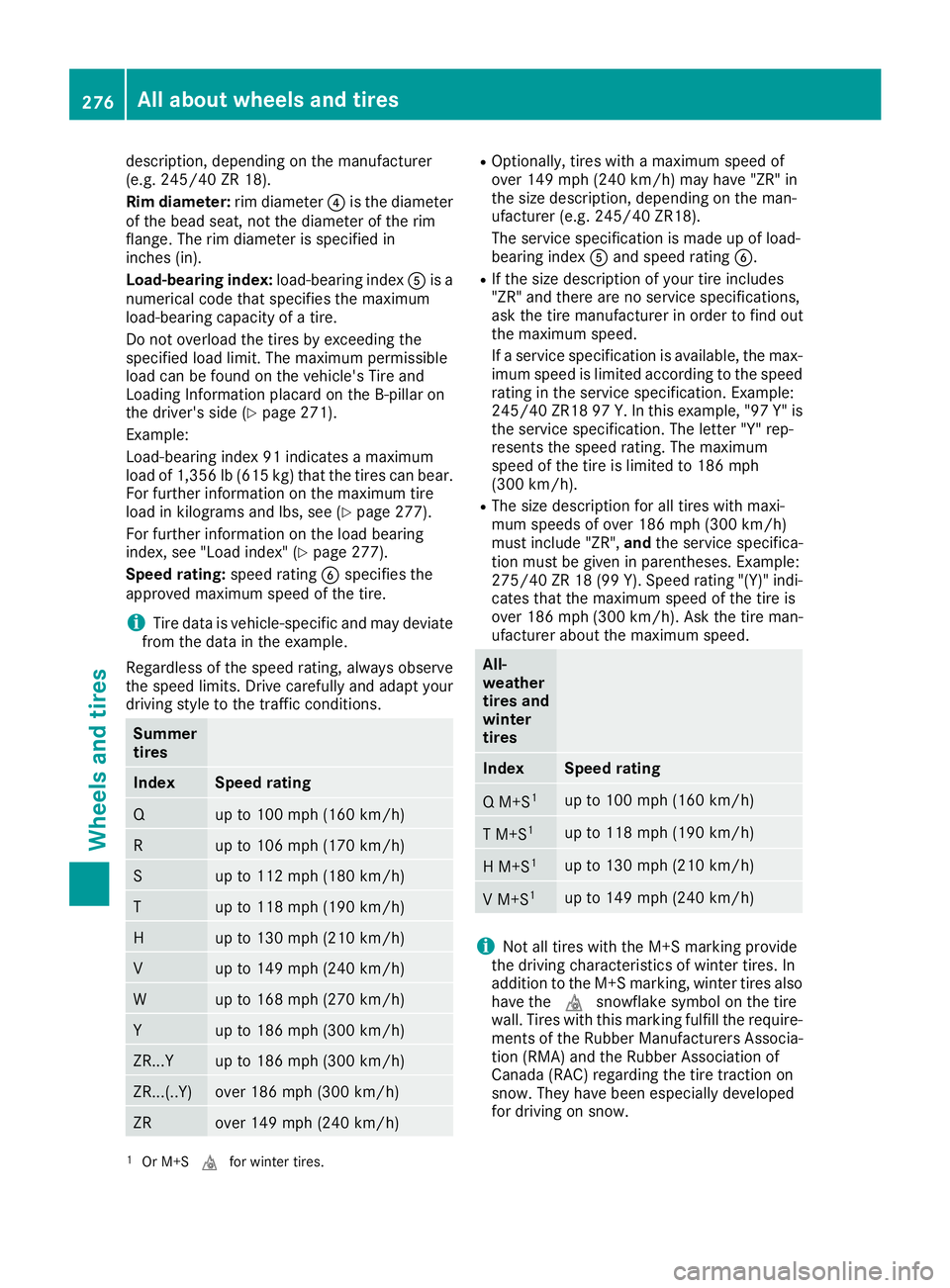
description, dependingonthe manufacturer
(e.g. 245/40 ZR 18).
Rim diameter: rim diameter?is the diameter
of the bead seat, not the diameter of the rim
flange. The rim diameter is specified in
inches (in).
Load-bearing index: load-bearing indexAis a
numerical code that specifies the maximum
load-bearing capacityofat ire.
Do not overload the tires by exceeding the
specified load limit. The maximum permissible
load can be found on the vehicle's Tire and
Loading Information placard on the B-pillar on
the driver'ss ide (
Ypage 271).
Example:
Load-bearin gindex 91 indicates amaximum
load of 1,356lb( 615 kg) that the tires can bear.
For further information on the maximum tire
load in kilograms and lbs, see (
Ypage 277).
For further information on the load bearing
index ,see "Load index "(
Ypage 277).
Speed rating: speed ratingBspecifies the
approved maximum speed of the tire.
iTire data is vehicle-specific and may deviate
from the data in the example.
Regardless of the speed rating, always observe
the speed limits. Driv ecarefully and adapt your
driving style to the traffic conditions.
Summer
tires
IndexSpeed rating
Qup to 100 mph (160 km/h)
Rup to 106 mph (170 km/h)
Sup to 112 mph (180 km/h)
Tup to 118 mph (190 km/h)
Hup to 130 mph (210 km/h)
Vup to 149 mph (240 km/h)
Wup to 168 mph (270 km/h)
Yup to 186 mph (300 km/h)
ZR...Yup to 186 mph (300 km/h)
ZR...(..Y)over 186 mph (300 km/ h)
ZRover 149 mph (240 km/h)
ROptionally, tires withamaximum speed of
over 149 mph (240k m/h) may have "ZR" in
the sized escription, depending on the man-
ufacturer (e.g .245/4 0ZR18).
The service specification is made up of load-
bearingi ndexAand speed rating B.
RIf the sizedescription of your tir eincludes
"ZR" and there are no service specifications,
ask the tir emanufacturer in order to findo ut
the maximum speed.
If as ervice specification is available, the max-
imum speed is limited accordingtot he speed
rating in the service specification .Example:
245/4 0ZR18 97 Y. In this example, "97 Y" is
the service specification .The letter "Y" rep-
resent sthe speed rating. The maximum
speed of the tir eislimited to 186 mph
(300k m/h).
RThe sized escription for all tires with maxi-
mum speeds of over 186 mph (300k m/h)
must include "ZR", andthe service specifica-
tion must be given in parentheses. Example:
275/4 0ZR18( 99 Y). Spee drating "(Y)" indi-
cates that the maximum speed of the tir eis
over 186 mph (300k m/h).A sk the tir eman-
ufacturer about the maximum speed.
All-
weather
tires and
winter
tires
IndexSpeed rating
QM +S1up to 100 mph (160k m/h)
TM +S1up to 118 mph (190k m/h)
HM +S1up to 130 mph (210k m/h)
VM +S1up to 149 mph (240k m/h)
iNot all tires with the M+S marking provide
the driving characteristics of winter tires. In
additio ntothe M+S marking, winter tires also
have the isnowflakes ymbol on the tire
wall. Tires with this marking fulfill the require-
ments of the Rubber Manufacturers Associa-
tion (RMA) and the Rubber Association of
Canada (RAC) regarding the tir etraction on
snow. They have been especially developed
for driving on snow.
1Or M+S ifor winter tires.
276All about wheels and tires
Wheels and tires
Page 279 of 298
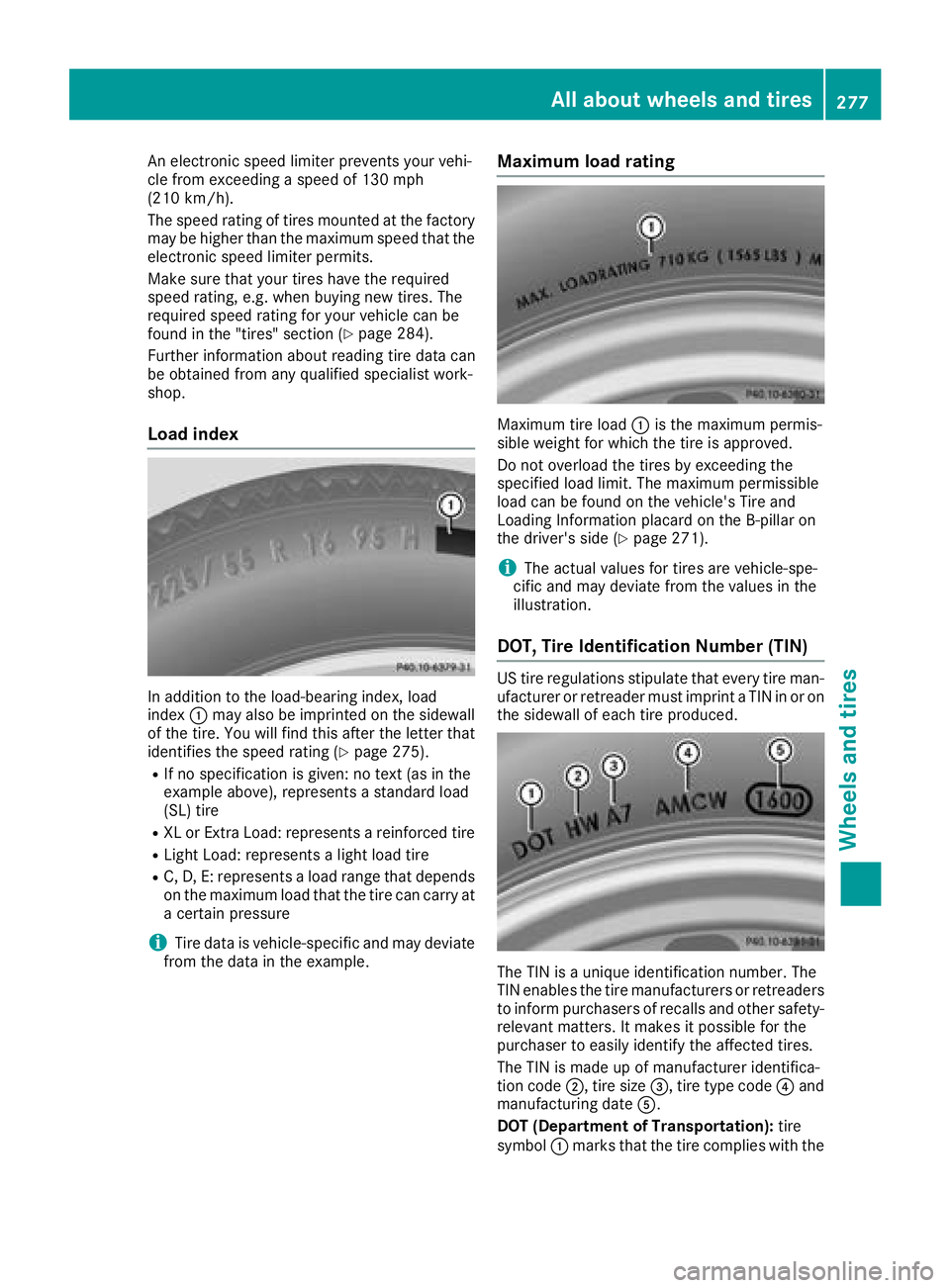
An electronic speed limiterprevents your vehi-
cle from exceeding aspeed of 130 mph
(21 0km/h).
The speed rating of tire smounted at the factory
maybeh ighe rthant he maximu mspeed thatt he
electronic speed limite rpermits.
Make sure thaty ourtire sh avet he required
speed rating ,e.g.w henb uyin gnew tires. The
required speed rating for your vehicl ecan be
found in the "tires "sectio n(
Ypage 284).
Further informatio nabout reading tire data can
be obtained from any qualified specialist work-
shop.
Load index
In additio ntothe load-bearing index, load
index :maya lsobei mprinte donthe sidewall
of the tire .You will find thisa fterthe letter that
identifie sthe speed rating (
Ypage 275).
RIf no specification is given: no text (a sinthe
exampl eabove), represents astandard load
(SL) tire
RXL or Extra Load: represents areinforced tire
RLight Load: represents alight load tire
RC, D, E: represents aloa dr ange thatd epends
on the maximu mloadt hatt he tire can carry at
ac ertain pressure
iTire data is vehicle-specific and mayd eviate
from the data in the example.
Maximum load rating
Maximu mtire load :is the maximu mpermis-
sibl ew eigh tfor which the tire is approved.
Do not overload the tire sbyexceeding the
specified load limit. The maximu mpermissible
load can be found on the vehicle's Tire and
Loading Informatio nplacard on the B-pillar on
the driver's side (
Ypage 271).
iThe actual values for tire sarevehicle-spe-
cifi cand mayd eviate from the values in the
illustration.
DOT, Tire Identificatio nNumbe r(TIN)
US tire regulations stipulate thate very tire man-
ufacturer or retreader must imprint aTIN in or on
the sidewall of each tire produced.
The TIN is auniqu eide ntificatio nnumber. The
TIN enables the tire manufacturer sorretreaders
to inform purchaser sofrecallsand othe rsafety-
relevant matters .Itmakes it possibl efor the
purchaser to easily identify the affecte dtires.
The TIN is made up of manufacturer identifica-
tio nc ode ;,t ire size =,tire typ ecode ?and
manufacturing date A.
DO T(De partment of Transportation): tire
symbol :marks thatt he tire complies with the
Alla bout wheels and tires277
Wheel sand tires
Z
Page 280 of 298
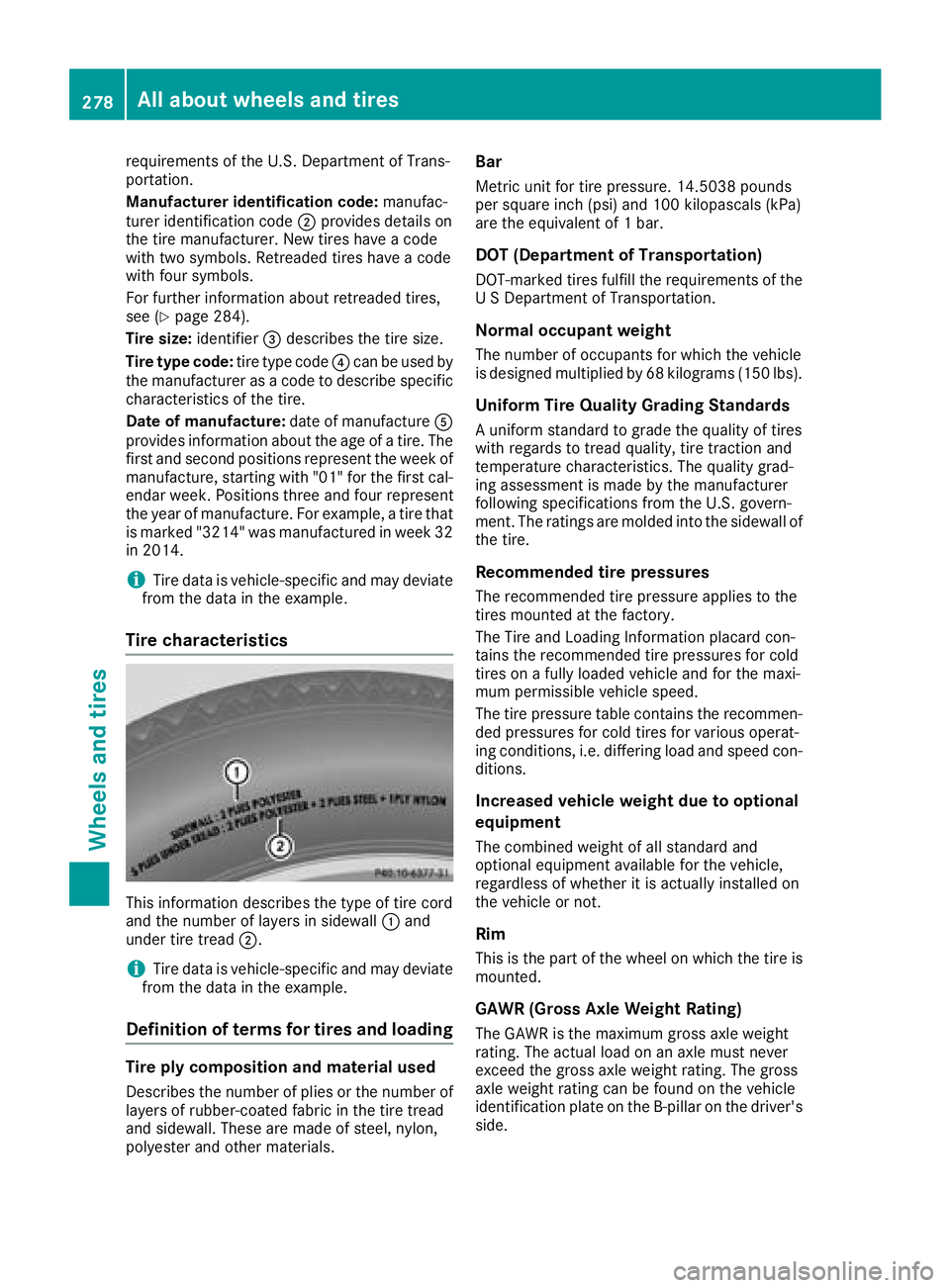
requirements of the U.S. Department of Trans-
portation.
Manufacturer identificationcode: manufac-
turer identification code ;provides details on
the tire manufacturer. New tires have acode
with two symbols. Retreaded tires have acode
with four symbols.
For further informatio nabout retreaded tires,
see (
Ypag e284).
Tire size: identifier=describes the tire size.
Tire type code: tire type code?can be used by
the manufacturer as acode to describes pecific
characteristics of the tire.
Date of manufacture: date of manufactureA
provides informatio nabout the age of atire. The
first and second positions represent the weeko f
manufacture, starting with "01" for the first cal-
endar week. Positions three and four represent
the yea rofmanufacture. For example, atire that
is marked "3214" was manufactured in week3 2
in 2014.
iTire data is vehicle-specific and may deviate
from the data in the example.
Tire characteristics
This informatio ndescribes the type of tire cord
and the number of layers in sidewall :and
under tire tread ;.
iTire data is vehicle-specific and may deviate
from the data in the example.
Definition of terms for tires and loading
Tire ply compositio nand material used
Describes the number of plies or the number of
layers of rubber-coated fabricint he tire tread
and sidewall. These are made of steel, nylon,
polyester and other materials.
Bar
Metric unit for tire pressure. 14.5038 pounds
per square inch (psi)a nd 100 kilopascals(kPa)
are the equivalent of 1bar.
DOT (Department of Transportation)
DOT-marked tires fulfill the requirements of the
USD epartment of Transportation.
Normal occupant weight
The number of occupants for which the vehicle
is designed multiplied by 68 kilograms (150 lbs).
Uniform Tire Quality Grading Standards
Auniform standard to grad ethe quality of tires
with regards to tread quality,t ire traction and
temperature characteristics. The quality grad-
ing assessment is made by the manufacturer
following specifications from the U.S. govern-
ment. The ratings are moldedi nto the sidewallof
the tire.
Recommended tire pressures
The recommended tire pressure appliestot he
tires mounted at the factory.
The Tire and Loading Information placard con-
tains the recommended tire pressures for cold
tires on afullyloaded vehiclea nd for the maxi-
mum permissiblev ehiclespeed.
The tire pressure table contains the recommen-
ded pressures for cold tires for various operat-
ing conditions, i.e. differing loada nd speedcon-
ditions.
Increased vehicle weight due to optional
equipment
The combined weight of all standard and
optionale quipment available for the vehicle,
regardless of whetheritisa ctually installed on
the vehicleorn ot.
Rim
This is the part of the wheelonw hich the tire is
mounted.
GAWR (Gross Axl eWeight Rating)
The GAWR is the maximu mgross axle weight
rating. The actua lloadonana xle must never
exceed the gross axle weight rating. The gross
axle weight rating can be found on the vehicle
identification plate on the B-pillar on the dri
ver's
side.
278Alla bout wheels and tires
Wheels and tires
Page 281 of 298
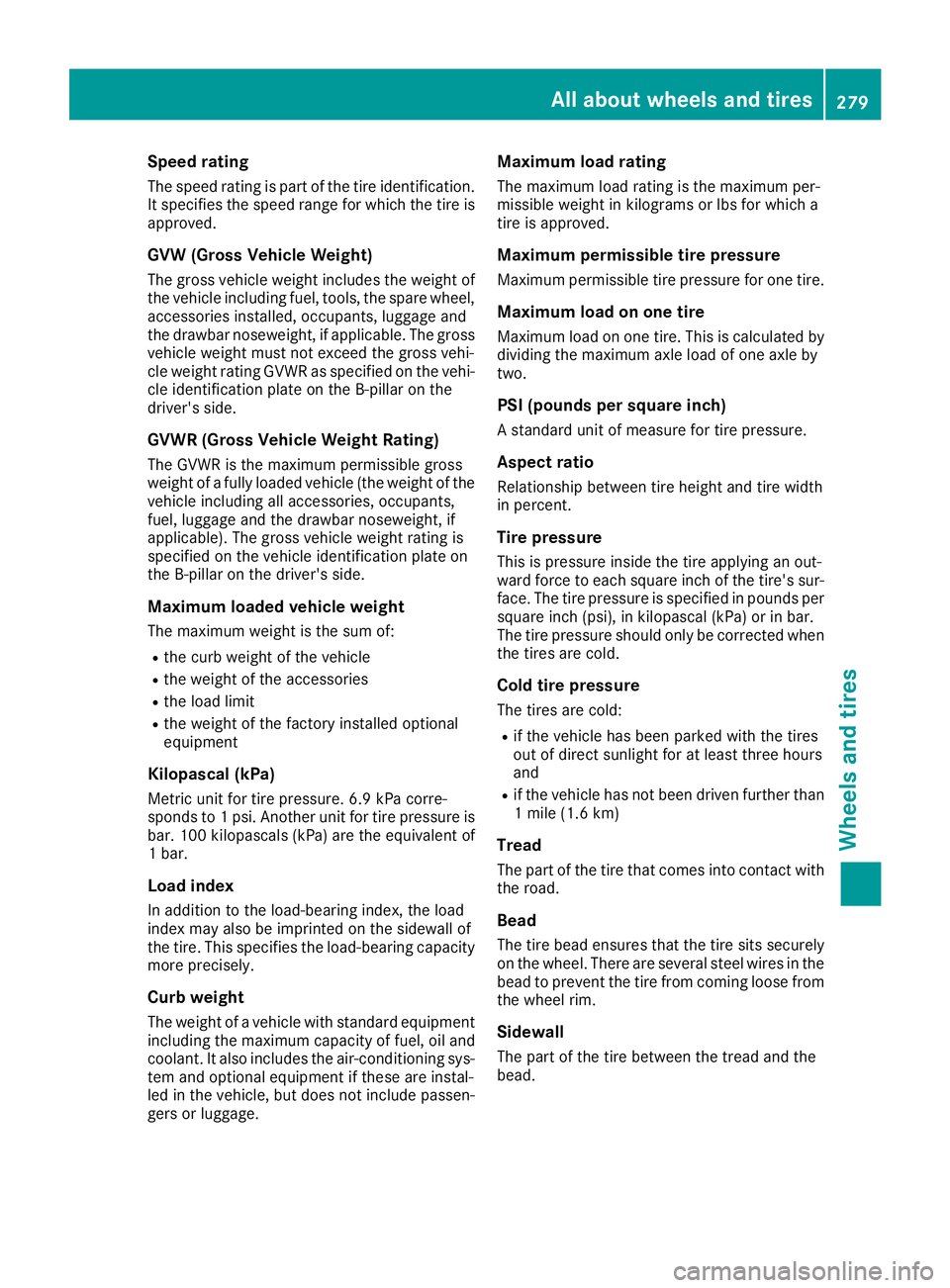
Speed rating
The speed rating is part of the tire identification.It specifies the speed range for which the tire is
approved.
GVW (Gross Vehicle Weight)
The gross vehicle weight includes the weight of the vehicle including fuel, tools, the spare wheel,
accessories installed, occupants, luggage and
the drawbar noseweight, if applicable. The gross
vehicle weight must not exceed the gross vehi-
cle weight rating GVWR as specified on the vehi- cle identification plate on the B-pillar on the
driver's side.
GVWR (Gross Vehicle Weight Rating)
The GVWR is the maximum permissible gross
weight of afully loaded vehicle (the weight of the
vehicle including all accessories, occupants,
fuel, luggage and the drawbar noseweight, if
applicable). The gross vehicle weight rating is
specified on the vehicle identification plate on
the B-pillar on the driver's side.
Maximu mloaded vehicle weight
The maximum weight is the sum of:
Rthe curb weight of the vehicle
Rthe weight of the accessories
Rthe load limit
Rthe weight of the factory installed optional
equipment
Kilopascal (kPa)
Metric unit for tire pressure. 6.9 kPa corre-
sponds to 1psi. Another unit for tire pressure is
bar. 100 kilopascals (kPa) are the equivalent of
1b ar.
Load index
In addition to the load-bearing index, the load
index may also be imprinted on the sidewallo f
the tire. This specifies the load-bearing capacity
more precisely.
Curb weight
The weight of avehicle with standard equipment
including the maximum capacity of fuel, oil and
coolant. It also includes the air-conditioning sys-
tem and optional equipment if these are instal-
led in the vehicle, but does not include passen-
gers or luggage.
Maximu mload rating
The maximum load rating is the maximum per-
missible weight in kilograms or lbs for which a
tire is approved.
Maximu mpermissible tire pressure
Maximum permissible tire pressure for one tire.
Maximu mload on one tire
Maximum load on one tire. This is calculated by
dividing the maximum axle load of one axle by
two.
PSI (pounds per squarei nch)
Astandard unit of measure for tire pressure.
Aspect ratio
Relationship between tire height and tire width
in percent.
Tire pressure
This is pressure inside the tire applying an out-
ward force to each square inch of the tire's sur-
face. The tire pressure is specified in pounds per
square inch (psi), in kilopascal (kPa) or in bar.
The tire pressure should only be corrected when the tires are cold.
Cold tire pressure
The tires are cold:
Rif the vehicle has been parked with the tires
out of direct sunlight for at least three hours
and
Rif the vehicle has not been driven further than
1m ile (1.6 km)
Tread
The part of the tire that comes into contact with
the road.
Bead
The tire bead ensures that the tire sits securely
on the wheel. There are several steel wires in the
bead to prevent the tire from coming loose from
the wheel rim.
Sidewall
The part of the tire between the tread and the
bead.
All about wheelsa nd tires279
Wheels and tires
Z
Page 282 of 298
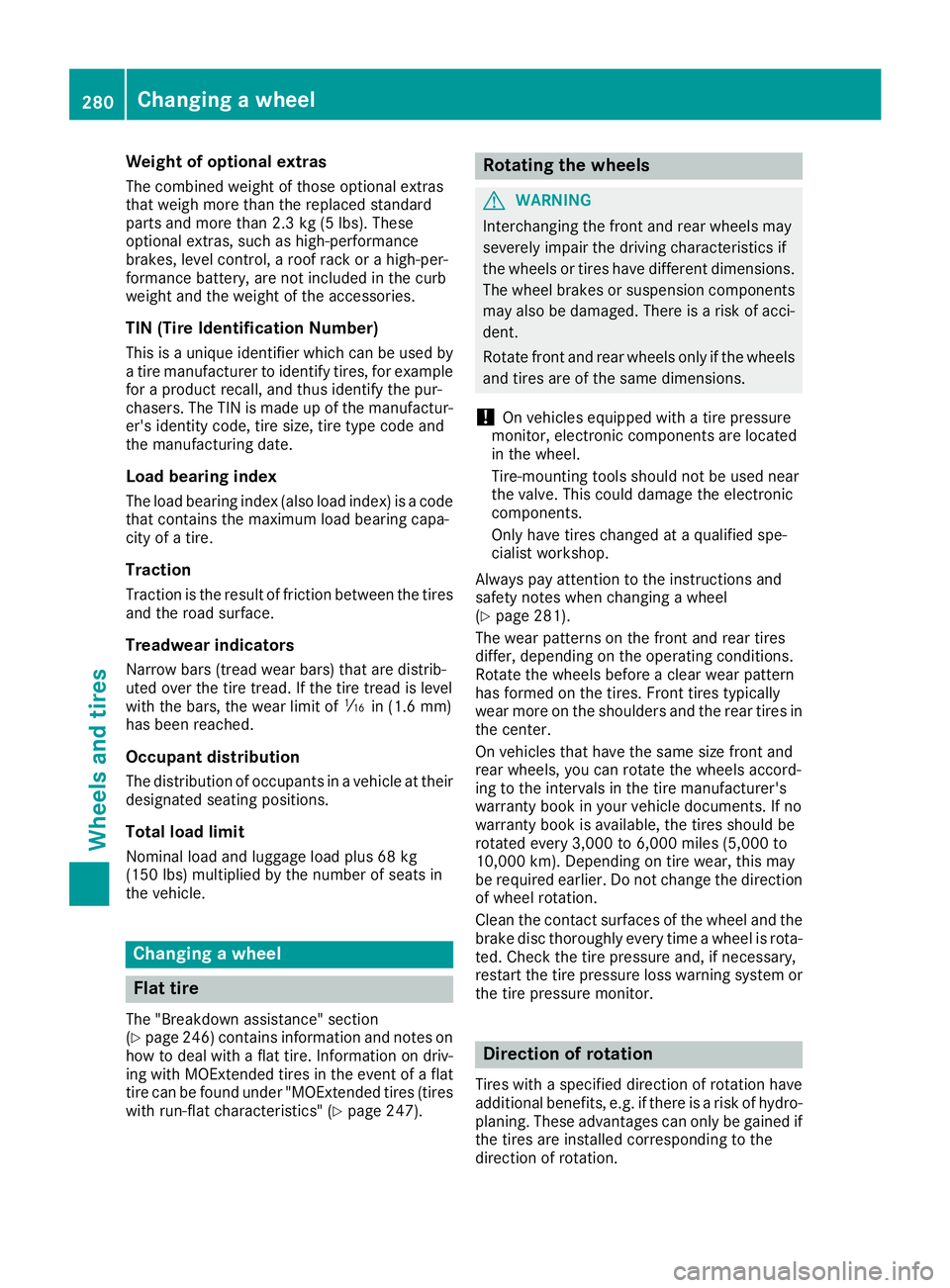
Weight of optional extras
The combined weight of those optionalextras
that weigh more than the replaced standard
parts and more than 2.3 kg (5 lbs).T hese
optionale xtras, such as high-performance
brakes ,levelc ontrol, aroof rack or ahigh-per-
formance battery,a re not included in the curb
weight and the weight of the accessories.
TIN (Tire Identification Number)
This is aunique identifier which can be use dby
at ire manufacturer to identify tires, for example
for aproduct recall, and thus identify the pur-
chasers. The TIN is made up of the manufactur-
er's identity code, tire size, tire type code and
the manufacturing date.
Load bearin gindex
The loadb earing index (also loadi ndex) isacode
that contains the maximu mloadb earing capa-
city of atire.
Traction
Tractio nisthe result of friction between the tires
and the road surface.
Treadwear indicators
Narrow bars (tread wearb ars)that are distrib-
uted over the tire tread. If the tire tread is level
with the bars ,the wearl imitofá in (1.6 mm)
has been reached.
Occupant distribution
The distribution of occupants in avehicleatt heir
designated seating positions.
Total load limit
Nominall oadand luggagel oadplus68kg
(150 lbs) multiplied by the number of seats in
the vehicle.
Changing awheel
Flat tire
The "Breakdown assistance" section
(Ypage2 46) contains information and notes on
how to dealw ithaflat tire. Informatio nondriv-
ing with MOExtended tires in the event of aflat
tire can be found under "MOExtended tires (tires
with run-fla tcharacteristics" (
Ypage2 47).
Rotating the wheels
GWARNING
Interchanging the front and rear wheels may
severely impair the driving characteristics if
the wheels or tires have different dimensions. The wheelb rakes or suspension components
may als obedamaged. There is arisk of acci-
dent.
Rotate front and rear wheels only if the wheels and tires are of the same dimensions.
!On vehicles equipped with atire pressure
monitor, electronic components are located
in the wheel.
Tire-mounting tools should not be use dnear
the valve .This coul ddamage the electronic
components.
Only have tires changed at aqualified spe-
cialist workshop.
Always pay attention to the instructions and
safety notes when changing awheel
(
Ypage2 81).
The wearp atterns on the front and rear tires
differ, depending on the operating conditions.
Rotate the wheels before aclearw earp attern
has formed on the tires. Front tires typically
wearm ore on the shoulders and the rear tires in
the center.
On vehicles that have the same size front and
rear wheels, you can rotate the wheels accord-
ing to the interval sinthe tire manufacturer's
warranty book in you rvehicled ocuments. If no
warranty book is available,t he tires should be
rotated every 3,000 to 6,000 mile s(5,000 to
10,000 km) .Depending on tire wear, this may
be required earlier. Do not change the direction
of wheelr otation.
Clean the contact surfaces of the wheela nd the
brake disc thoroughly every time awhee lisr ota-
ted. Check the tire pressure and, if necessary,
restart the tire pressure loss warning system or
the tire pressure monitor.
Directio nofrotation
Tires with aspecified direction of rotation have
additionalb enefits, e.g. if there is arisk of hydro-
planing. These advantages can only be gained if
the tires are installed corresponding to the
direction of rotation.
280Changing awheel
Wheels and tires
Page 283 of 298

An arrow on the sidewall of the tire indicates its
correct direction of rotation.
Storingwheels
Store wheels thata renot being used in acool,
dry and preferably dark place .Protect the tires
from oil, grease, gasoline and diesel.
Mounting awheel
Preparin gthe vehicle
XStop the vehicl eonsolid,non-slippery and
level ground.
XApply the electri cparking brake manually.
XBring the front wheels into the straight-ahead
position.
XShift the transmission to position j.
XSwitch off the engine.
XVehicles withoutKEYLESS -GO:remove the
SmartKeyf rom the ignition lock.
XVehicles with KEYLESS-GO: open the driv-
er' sd oor.
The vehicl eelectronics now have status 0.
Thi sist he same as the SmartKeyh aving been
removed.
XVehicles with KEYLESS-GO: remove the
Start/Stop button from the ignition lock
(
Ypage 116).
XIf included in the vehicl eequipment ,remove
the tire-change tool kit from the vehicle.
XSafeguar dthe vehicl eagain st rolling away.
iDue to difference sinvehicleequipment ,not
al lv ehicles ar eequippe dwithat ire-change
tool kit. For informatio nonwhich tool sare
required to performaw heelchange on your
vehicle, consult an authorize dMercedes-
Benz Center.
Necessary tire-changing tool scan include, for
example:
RJack
RWheel chock
RLugw rench
Securin gthe vehicle to preven titfrom
rolling away
If your vehicl eisequippe dwithaw heelchock, it
can be found in the tire-change tool kit
(
Ypage 245).
The folding whee lchoc kisana dditional safety
measure to prevent the vehicl efrom rolling
away ,for exampl ewhenc hanging awheel .
XFoldb othp late su pwar ds:.
XFoldo utlowe rplate ;.
XGuid ethe lugs on the lowe rplate full yinto the
openings in base plate =.
XPlace chocks or others uitabl eitems under
the front and rea rofthe whee lthati sdiago -
nally opposite the whee lyou wish to change.
Raisin gthe vehicle
GWARNING
If yo udon ot positio nthe jack correctl yatthe
appropriate jacking point of the vehicle, the
jack could tip overw itht he vehicl eraised.
There is ariskofi njury.
Onlyp ositiont he jack at the appropriate jack-
ing point of the vehicle. The base of the jack
Changin gawheel281
Wheel sand tires
Z